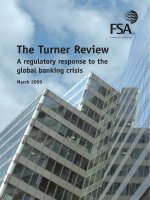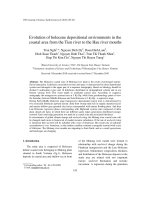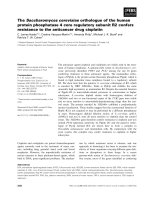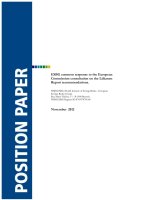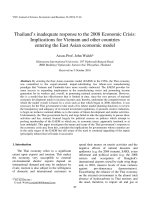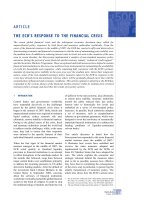ESBG common response to the European Commission consultation on the Liikanen Report recommendations pot
Bạn đang xem bản rút gọn của tài liệu. Xem và tải ngay bản đầy đủ của tài liệu tại đây (280.36 KB, 9 trang )
ESBG common response to the European
Commission consultation on the Liikanen
Report recommendations.
WSBI-ESBG (World Institute of Savings Banks - European
Savings Banks Group)
Rue Marie-Thérèse, 11 - B-1000 Brussels
WSBI-ESBG Register ID 8765978796-80
November 2012
2
Doc 1182/2012
First of all, the European Savings Banks Group (ESBG) welcomes the opportunity to share its views
and opinions on the Report provided by the High-level Expert Group on banking reform chaired by
Mr. Liikanen, the “Liikanen Group”.
I. General observations
The ESBG appreciates the efforts of the European Commission and the Liikanen Group to
strengthen financial stability in the European banking landscape. The ESBG also welcomes
the fact that the Liikanen Group brings the risky practices of investment banking including
proprietary trading, shadow banking and the ‘Too big to fail-Problem’ to the spotlight,
leaving aside the “Vickers Report” approach. In this sense, we appreciate that these
proposals do not include any increase in capital requirements for retail banks and do not
envisage a separation of businesses for the entire banking system - in particular for the small
savings and retail banks.
Nevertheless, a first assessment of the report leads us to reiterate our doubts about the need
for further regulatory reforms for the banking industry. The ESBG is of the opinion that
there is an excess of financial regulation taking place that might result in an excessive and
inflexible regulation, and in many cases will lead to overlaps between the different
regulations, as well as unintentional consequences. The Liikanen Group’s proposals aim to
tackle some of the problems that have been addressed by different regulation proposals such
as CRD IV, the Crisis Management proposal, Governance and the DGS Review. Given that
many of these regulatory reforms, which are of considerable impact, are still under
discussion and their final outcomes are not yet certain, we consider that it has not been
appropriate to include further proposals on the mentioned files (some of them putting
forward tougher approaches) in the Liikanen Report. Therefore, the ESBG wonders why the
European Commission does not try to put forward these regulatory reforms instead of
attempting to devise a more thorough banking reform. Indeed, the ESBG considers that it
would be more valuable to concentrate on the implementation of the current regulation
which still has to be defined and refined. As a result, the ESBG considers that there is not a
clear need for this debate at the current stage.
From our perspective the adequate answer to the underlying problem of deficient risk
management in some institutions would be improved supervision and an improvement of
the loss absorbency in the own funds of institutions as already proposed in the reforms
under implementation. In our view the additional risk capital requirements included in the
3
Basel 2.5 and Basel III frameworks of three to four times higher capital charges for trading
activities should be sufficient. Banks should be left room for manoeuvre to allow
diversification and a more efficient capital allocation. Proper capitalisation, strengthening
banks’ diversity and appropriate regulations are the main factors of a stable and well-
functioning banking sector and should hence be the focus of any further improvement. For
the time being, the ESBG does not see any mandatory changes as being necessary for the
European universal banking system. A potential need for separation in order to reduce
systemic risk should be analysed by the supervisor on an individual basis.
The ESBG is of the opinion that, in general, the universal banking model coped much better
with the financial crisis than the separate banking system. We would like also to stress the
relevance of the retail and savings banks model for the provision of lending to the economic
activity in Europe. We consider that those institutions and business models that have proved
long-term to be involved in the provision of banking services to the economic activity
should be treated in a more favourable way.
The ESBG agrees with the Liikanen Group on the identification of the main drivers of the
crisis: insufficient and uncoordinated supervision, inadequate risk management and excessive
reliance on short term funding. In fact, we consider that these problems have already been
addressed by existing or newly prepared regulations.
Furthermore, a concrete assessment of the impact of the proposal cannot yet be carried out
by financial institutions until the concrete proposals are made. For the time being the
recommendations lack the sufficient clarity or precision to understand the eventual effects
that can stem from the implementation of the proposals. Therefore, the ESBG supports the
European Commission’s intent to carefully consider the possible impact (with an appropriate
and independent cost-benefit analysis) that the implementation of these recommendations
might have on the banking industry and the European economy before endorsing them or
proposing any legal reform.
Although we appreciate the effort made to target the more risky institutions and activities,
we still have some doubts about how the thresholds system for ring-fencing trading activities
would be applied. It seems to be very difficult to assess which activities would fall under the
threshold and which would fall outside, and moreover this will probably lead to similar legal
disputes as created by the Volcker Rule. The Liikanen Group has not come out with
concrete proposals; as a matter of fact the threshold system set up a 15-25% limit and does
not specify the activities that would be in or out. This lack of clarity might create
uncertainties in the banking industry for those financial institutions that do not yet know if
they will eventually be under the scope at a time when there is lot of market stress due to the
financial crisis. This uncertainty is even greater when it is not even clear what the final
measures to be applied will be.
4
The ESBG is also concerned for the activities that would be included in the ring-fence. In
the Liikanen Report it is said that assets held for trading would be included for the sake of
the calculation of trading assets. The ESBG believes that this approach would create serious
problems for the management of asset portfolios, affecting a great number of fixed-term
assets held to comply with the liquidity coverage ratio amongst other reasons. We consider
that for the sake of the calibration of the trading activities it would be more appropriate to
opt for the held for trading assets instead of the available for sale portfolio.
We are also concerned with the inclusion of market making activities within the ring-fence:
market making activities provide a service for companies that need to hedge risk arising from
their business activities. Furthermore, these activities provide services for governments
issuing sovereign debt and banks issuing senior debt including covered bonds issued in order
to fund lending to the real economy. Due to the difficulty of carrying out this definition, the
Liikanen Group has opted to place into the ring-fence all the market making activities. This
decision could lead to a negative impact for the European banking industry as the ring-
fencing would incur an increase in funding costs for these ring-fenced investment banks that
engage in market-making activities and could – especially for small currency countries –
reduce market liquidity dramatically.
Comments on the Analysis of businesses models provided by the Liikanen Report:
The report presents an interesting analysis concluding that there are entities within all business
models that have failed during the crisis. The ESBG is of the opinion that although institutions from
different natures and business models have suffered the effects of the crisis, generally speaking, the
savings and retail banks’ business model has not engaged in those excessive risk taking practices–
often in trading highly-complex instruments coupled with excessive reliance on short-term funding
in the run-up to the financial crisis – that according to the Liikanen Report have been in the root of
the financial crisis. Therefore, we consider that a differentiation between different business models
would be convenient and should be contemplated.
The Report states several conclusions on the evolution of the banking industry. It states that the
financial institutions have abandoned their key aim of providing banking services to the real
economy based on the following facts: the share of lending provision to the clients out of all the
activities and incomes of an institution has decreased; the weight of interest surpluses in the total
income of an institution has decreased; the concentration on proprietary trading activities have
increased.
The ESBG would like to state that when it comes to savings and retail banks the proportion of
customer loans and customer deposits of non-banks has remained relatively constant in recent years
(at 60-70% of total assets) and that the net interest income continues to be the main source of
income for savings banks and several retail banks (accounts for about ¾ of their ordinary income).
5
Moreover, we believe that the measures taken should be flexible enough to be compatible with all
types of banking models, including universal banking and the savings and retail banks’ business
model. The ESBG welcomes the recognition of the universal banking model. However, the ESBG
also states that every financial system has its own particular characteristics; there are diverse banking
structural models and practices within the EU which need to be fully respected. Applying the same
banking model - the ‘one size fits all’ approach - across the EU could result in a lack of flexibility
and reduce the benefits of diversification. In fact, these issues would not be consistent with the
founding principles of the EU. As a result, ESBG strongly affirms that any eventual banking
structural reform should take into consideration the diversified nature of the banking industry in
Europe, paying special attention to those banking models that have a closer link to economic activity
- both at local and regional level, and to SME lending.
Comments on the Ring-fence approach:
Another conclusion that can be drawn from the analysis is that the lack of proper risk management
seems to be what has failed in recent years, rather than any particular business model. A natural next
step in the analysis is to conclude that banking reforms aiming at avoiding new banking crises should
focus on measures that will improve risk management in banks, rather than ring-fencing trading and
market making activities.
The conclusion that trading business should be ring-fenced from other forms of banking business
within the same banking group is not obvious from our point of view. The report claims that with
ring fencing, risks are reduced while saving the universal banking model. The ESBG does not share
this position. The ring-fence might entail a big structural change for those institutions that will fall
inside the fence: they will have to build a separate capitalised entity that will not be allowed to
engage in deposit taking activities. However, they could still operate inside the same banking holding
structure. Therefore, the main impact will be in terms of restructuration and organisational costs,
although capital surcharges could be also envisaged. The ring-fencing model may make the universal
bank riskier (in relation to total risk capital in the group) and less effective since the group’s ability to
take benefit from diversified risks and internal synergies is reduced. Additionally the ring-fence
approach would probably increase the capital needed within a banking group subject to the ring-
fence, not least because the trading entity will need a high capital cushion in order to be able to
attract funds. More capital may compensate for the higher risk level, but the capital will be used in a
less efficient way than without a ring-fence. The ring-fence approach may also reduce liquidity in
financial markets since it will be more costly for banks to uphold trading and market making
activities. This in turn would make it more expensive for all actors in the market (banks, their
customers and other actors) to fund themselves and to manage their financial risks. As a general
consequence, banking services will become more costly for the customers. This impact will in
particular be important in smaller non-euro countries where there is a higher need both for banks
and the private sector to manage the risks associated with cash flows in foreign currencies, e.g.
export income, payments for imports and funds borrowed in foreign currencies.
6
Activities to be included in the ring-fence calibration:
Concerning the first threshold, we do not see any reason to refer to the volume of the Available for
Sale portfolio (AfS). The AfS portfolio is a banking book portfolio which is widely used for
asset/liability steering purposes. The volume of this portfolio is not a good indicator for the volume
of proprietary trading. In page 101 of the Report it is clearly set out that these assets shall not be
included in the ring-fence. Also the held for trading portfolio as such is not a good indicator as this
portfolio covers not only proprietary trading.
The needed volume of such assets will increase further with the forthcoming Basel III requirements.
As an example, certain countries have already transposed the Basel III LCR requirement to their
domestic legislation. As a consequence, financial institutions from these countries that have to fulfil
the Basel III LCR requirements already from 1 January 2013, are currently holding 15-20% of their
assets in liquidity portfolios. In general, European banks are already increasing their liquidity
portfolio in order to be able to meet the LCR requirements.
The funds in these portfolios must either be invested in high quality liquid securities (reported as
held for trading or available for sale) or placed as deposits in central banks.If the Basel III proposal
regarding the Net Stable Funding Ratio (NSFR) requirement is implemented, the liquidity portfolio
required will increase even further. If the assets held in banks’ liquidity portfolios and reported as
held for trading or available for sale are included in the threshold calculations, this will give banks
aiming at avoiding ring-fencing a strong incentive to place its funds as deposits at central banks
rather than in invest in securities (e.g. high quality government bonds). The behaviour of banks
should be analysed in detail. We fear that it will result in unwanted directions. Therefore we suggest
that banks’ liquidity- and ALM-portfolios are excluded from the threshold calculations already at
stage 1.
Furthermore, we would like to highlight the existing difference between available for sale and held
for trading assets. Due to the IAS (International Accounting Standards) definitions regarding AfS,
according to IAS 39, AfS financial assets are those non-derivative financial assets that are designated
as AfS, or are not classified as: loans and receivables or HTM (Held to maturity) investments, are
not held for trading and are not designated as at FVTPL (Fair Value Through Profit and Loss) on
initial recognition. Given that per definition assets held for trading cannot be included in AfS it
would be completely misleading to assess the requirement for a mandatory legal separation of
proprietary trading activities and other significant trading activities on the volume of the AfS
portfolio. One of the most important financial asset classes included in AfS are financial assets held
for liquidity purposes. Based on the Liquidity Coverage Ratio required by the Basel III framework,
banks have to ensure that sufficient high quality liquid resources are available for 30 days in case of a
stress scenario. Although this requirement will only be introduced in 2015, banks are already
preparing to meet this new ratio. The European Banking Authority (EBA), in its second report of
the Basel III monitoring exercise (which presents the aggregate results on capital, risk-weighted
7
assets (RWAs), leverage and liquidity ratios in EU member states, published on 27 September 2012),
concludes that “Compared to the previous period, monitoring results show improved liquidity ratios for both Group
1 and Group 2 banks with a substantial dispersion across banks and countries.” Banks that increased their
stock of unencumbered, high quality liquid assets in order to promote their short-term resilience to
potential liquidity disruptions, will now be punished if they designate these assets as AfS. Therefore
any sensible assessment of a required legal separation of trading activities must not be based on AfS
but must include the trading purpose as its main parameter.
The Liikanen Report has opted for not providing any definition of proprietary trading or market
making activities, which is the most sensitive issue when prescribing a mandatory separation. The
ESBG is of the opinion that ring-fencing market making activities will substantially harm the
liquidity of markets since banks will get incentives for winding down these activities. This will harm
all markets also thosewith medium to low liquidity – especially for instance the secondary bond
market, but also exchange traded funds, or investment certificates, which becomes even more
harmful in smaller markets. This would not only hit financial investors but also retail customers. In
ESBG’s view, market making activities have nothing to do with speculation but they are a customer
related business. Legislators/regulators should keep in mind that market making is a substantial part
of the provision of financial products, like bonds (including governmental bonds), exchange traded
funds, or investment certificates. Therefore, it seems reasonable from an economic perspective that
these activities remain linked to the deposit taking activities. Due to their branch networks and other
distribution channels, deposit taking banks are the main distributors of such financial instruments
throughout the European Union. Moreover, it is clear that fundamental risks do not arise from
market making activities related to the distribution of financial instruments and that these activities
played no role in the triggering of the financial crisis. Furthermore, market making activities provide
a service for companies that need to hedge risk arising from their business activities.
To illustrate why the ring-fencing of market making activities would be that detrimental an example
can be provided: Since the Liikanen Report does not recommend including underwriting within the
ring-fence, commercial banks could still engage in these activities. Nevertheless, if these banks were
to go to the secondary market to place these securities, then this activity would be considered as
market making and therefore would be included in the ring-fencing scope. This will surely entail
additional interests for the companies that demand these underwriting services due to the separation
and the additional costs stemming from a more expensive funding. The corporations that demand
these types of activities would probably opt for these institutions that can engage in both types of
activities.
Another item that creates uncertainty and remains unclear from the Liikanen Report is how the
trading entity should be funded in the context of the mandatory separation: Additionally, many
other questions arise about how this separation would be implemented and how the ring-fence
would be integrated in the existing legal framework:
It seems likely that the trading entity will be required to issue its own bonds. It is however
unclear which group of investors will be attracted by an undiversified business model only
8
comprising of proprietary trading activities. It is reasonable to assume that the trading entity
will be required to hold significant volumes of capital in order to attract any investors.This
will make its services expensive and thereby reduce the private sector’s ability to hedge
financial risks. This in turn will reduce private sector output since higher margins will be
required in order to manage the higher volatility in earnings that can be assumed when
financial risks are not hedged properly.
If the funding should take place via the holding, and the holding via external sources: Does
that mean that in the relationship between holding and trading entity a zero risk weight for
large exposures and solvency purposes should apply?
How does the trading entity ensure that it is not indirectly funded by the deposit bank via
the holding? If we understand correctly, this would mean that the waiver envisaged in
Articles 6 and 7 of the CRR would not apply for the deposit bank or for the trading entity
(as it is being said that these entities should comply with all regulatory requirements on a
stand-alone basis)? If yes: What is the room for application of Articles 6 and 7 of the CRR?
What is the risk weight of exposures of the deposit bank to the trading entity in terms of
solvency (we assume that normal banking risk weight would apply, i.e. no intra-group zero
risk weight)? How is a missing zero-risk weight being argued before the background that a
consolidated requirement for the whole group should also apply (or should this requirement
be abolished)?
With regards to the Liquidity Coverage Ratio and Net Stable Funding Ratio, do these ratios
also have to be fulfilled on a standalone and consolidated basis? Should a waiver (Article 7 of
the CRR) be possible? What exactly is the benchmark for “at arm’s length”? All these
questions remain unanswered.
Bail-in-capital:
The proposal to ban financial investors from investing in bail-in-able capital seems to be an
exaggerated and extreme approach that we strongly oppose. We cannot follow the argumentation.
This proposal would have further detrimental effects on the funding and capitalisation of banks.
Leverage ratio:
The ESBG does not agree with the Liikanen Report’s views on the leverage ratio. We reject the
proposal that recommends a higher general leverage ratio. The leverage ratio is still undifferentiated
and detrimental for those banks that have a low-risk business model. This increase can only be
justified for those institutions that hold assets for which valuation is extremely uncertain.
